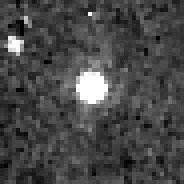 Hubble Space Telescope image of 2005 RN43, taken in April 2010 | |
| Discovery[1] | |
|---|---|
| Discovered by | A. C. Becker A. W. Puckett J. M. Kubica |
| Discovery site | APO |
| Discovery date | 10 September 2005 |
| Designations | |
| (145452) 2005 RN43 | |
| TNO Cubewano[2][3] Extended (DES)[4] | |
| Orbital characteristics[2] | |
| Epoch 13 January 2016 (JD 2457400.5) | |
| Uncertainty parameter 3 | |
| Observation arc | 22376 days (61.26 yr) |
| Earliest precovery date | 2 June 1954 |
| Aphelion | 42.146 AU (6.3050 Tm) |
| Perihelion | 40.571 AU (6.0693 Tm) |
| 41.359 AU (6.1872 Tm) | |
| Eccentricity | 0.019047 |
| 265.99 yr (97151.5 d) | |
Average orbital speed | 0.0037°/d |
| 338.28° | |
| 0° 0m 13.34s / day | |
| Inclination | 19.313° |
| 186.93° | |
| ≈ 15 June 2029[5] ±9 days | |
| 174.88° | |
| Earth MOID | 39.5672 AU (5.91917 Tm) |
| Jupiter MOID | 35.6155 AU (5.32800 Tm) |
| TJupiter | 5.446 |
| Physical characteristics | |
| Dimensions | 679+55 −73 km[6] |
| 6.95 h (0.290 d) | |
| 5.62 h[2] | |
| 0.107+0.029 −0.018[6] | |
| IR–RR (red)[6] B–V=0.95±0.02[7] V–R=0.59±0.01[7] V–I=1.08±0.02[7] | |
| 20.1[8] | |
| 3.89±0.05[6] 3.9[2] | |
(145452) 2005 RN43 (provisional designation 2005 RN43) is a classical Kuiper belt object. It has an estimated diameter of 679+55
−73 km.[6] It was discovered by Andrew Becker, Andrew Puckett and Jeremy Kubica on 10 September 2005 at Apache Point Observatory in Sunspot, New Mexico. Brown estimates that it is possibly a dwarf planet.[9][10]
- ^ Cite error: The named reference
MPC-TNO-listwas invoked but never defined (see the help page). - ^ a b c d Cite error: The named reference
jpldatawas invoked but never defined (see the help page). - ^ Cite error: The named reference
MPEC 2009-R09was invoked but never defined (see the help page). - ^ Cite error: The named reference
Buiewas invoked but never defined (see the help page). - ^ JPL Horizons Observer Location: @sun (Perihelion occurs when deldot changes from negative to positive. Uncertainty in time of perihelion is 3-sigma.)
- ^ a b c d e Cite error: The named reference
TNOsCool6was invoked but never defined (see the help page). - ^ a b c Cite error: The named reference
Belskaya2015was invoked but never defined (see the help page). - ^ Cite error: The named reference
AstDyswas invoked but never defined (see the help page). - ^ Michael E. Brown. "How many dwarf planets are there in the outer solar system? (updates daily)". California Institute of Technology. Archived from the original on 2011-10-18. Retrieved 2011-08-25.
- ^ Tancredi, Gonzalo (2009), "Physical and dynamical characteristics of icy "dwarf planets" (plutoids)", Proceedings of the International Astronomical Union, 5: 173–185, Bibcode:2010IAUS..263..173T, doi:10.1017/S1743921310001717